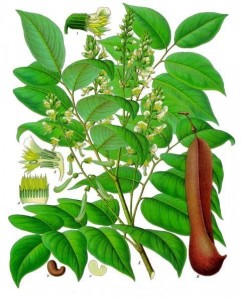Myroxylon balsamum from Koehler’s Medicinal Plants (1887)
Trade Name: Santos mahogany, Balsamo.
Genus: Myroxylon balsamum
Janka Hardness (pounds-force): 2200
Description: A highly invasive species. The coloration can be all over the place with Santos mahogany. It ranges from a light tan with pinkish hues to a deep almost purple brown. I’ve never seen a species so specific to a task—if you’re reading this, you’re very likely looking for interior flooring. Santos mahogany is richly textured, with a straight to highly irregular grain pattern. The oils in balsam are used as a fragrance in perfumes, and predictably, the wood exudes a spicy scent when working. Santos mahogany is not a true mahogany (Swentia), and it isn’t of the family Maliaceae (African mahogany and Spanish Cedar belong to this family.) Santos mahogany is generally harder and much more difficult to work than the counterparts listed above.
Location: Central and South America, namely: Mexico, Nicaragua, Belize, Guatemala, Costa Rica, Panama, Columbia, Honduras, Peru, Paraguay, Uruguay, Brazil.
Common Aliases: Arbol de balsamo, Balsamito, Balsamo de San Salvador, Balsamo negro, Caboreiba vermelha, Cabreuva, Cabreuva vermelha, Cabriziva, Cedro chino, Chucte, Greybark pine, Incienso, Incienso Colorado, Pau de balsam, Pau vermelho, Quina, Quina morada, Sandalo, Tolu.
Performance: Quite hard, and moderately difficult to work. Will blunt tools noticeably when working. The composition of the wood (interlocking, wavy grain) makes working Santos mahogany a challenge. Maybe that’s why everyone uses it almost exclusively in flooring. Makes sense, I guess. Santos mahogany appears to be nearly exclusively used as an interior product, though the species rates well against moisture and insect.
Affordability: $$$ Generally affordable for higher-end flooring applications.
Common Uses: Flooring, countertops, furnishings, stair nosings, ship building, railroad ties, heavy construction.
From: The Wood Database:
Common Name(s): Santos Mahogany
Scientific Name: Myroxylon balsamum
Distribution: Southern Mexico and Central and South America
Tree Size: 65-100 ft (20-30 m) tall, 2-3 ft (.6-1.0 m) trunk diameter
Average Dried Weight: 60 lbs/ft3 (960 kg/m3)
Basic Specific Gravity: .77
Hardness: 2,200 lbf (9,790 N)
Rupture Strength: 22,770 lbf/in2 (157,000 kPa)
Elastic Strength: 2,430,000 lbf/in2 (16,760 MPa)
Crushing Strength: 12,250 lbf/in2 (84.5 MPa)
Shrinkage: Radial: 3.8%, Tangential: 6.2%, Volumetric: 10.0%, T/R Ratio: 1.6
